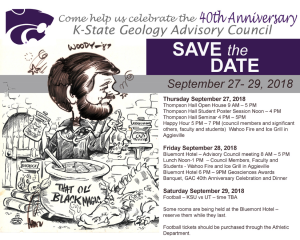Save the date! We’re looking forward to seeing as many of you as possible to celebrate the 40th anniversary of the K-State Geology Advisory Council.
Category: Spring 2018
Welcome to Dr. Arash Kamari
The department of Geology is please to introduce our new postdoctoral researcher working with Dr. Matt Totten. Continue reading “Welcome to Dr. Arash Kamari”
Constraining water migration aquifers with microgravity data
Water is one of the precious resources on the planet. As surface water supply has become less reliable and predictable, we rely more and more on groundwater. Continue reading “Constraining water migration aquifers with microgravity data”
Highlight on Undergraduate Research
Undergraduate student Mikaela Raeder first became interested in Optically Stimulated Luminescence (OSL) dating during her Fall 2016 Geomorphology course, instructed by Dr. Joel Spencer. During this course, she had the opportunity to carry out a small-scale project on the dating of quartz crystals collected from the exposed fluvial terraces along Kings Creek on Konza Prairie Biological Station (Figure 1). This experience sparked her interest in undergraduate research and her current project on phytoliths. Continue reading “Highlight on Undergraduate Research”
KSU Geologist Saugata Datta Receives Prestigious NASA PSTAR Grant
Humans have looked for extraterrestrial biosignatures on the surfaces of other planets and moons. These surfaces are often exposed to conditions and processes that exceed the physical limits of life, e.g., intense cosmic radiation, impact events, and large thermal extremes that would render difficult the preservation of biosignatures over geologic time. Planetary caves provide protection from cosmic radiation, small-scale impact events, and have relatively stable thermal environments. These characteristics may well permit preservation of biosignatures over long periods of time and make them a prospective astrobiology target for biosignatures beyond Earth (Boston et al., 2001; Léveillé & Datta, 2010; Martins et al., 2017). A cave (here more specifically basaltic lava tube caves) with natural openings offers direct access to the subsurface without drilling and deeper penetration into subsurface materials than could be obtained from a rover, landed platform, or penetrator launched from orbit. The purpose of this project is to develop the technology needed to enter a planetary cave with a scientific payload for deployment. The proposal, funded by NASA PSTAR [Planetary Science and Technology Through Analog Research] 16-PSTAR16_2_0015: Biologic and Resource Analog Investigations in Low Light Environments (BRAILLE) NNH16ZDA001N- funded through Aug 2020, is headed by Saugata Datta from the Kansas State University side and is in collaboration with NASA AMES, Northwestern U, Desert Research Institute, New Mex Tech. The research will focus on: 1) the identification of planetary lava caves, 2) development of subsurface exploration vehicles with advanced subsurface communications/operations techniques, and 3) development of sensor systems for biosignature identification. Dr Datta and colleagues will also focus on understanding the hydrochemistry of the cave waters, microbiome of lava caves on Earth; and focus on microbial colony morphology and association with secondary mineralogy, 16S rDNA of bacteria and identifying potential energy/chemical nutrient pathways to support microbial life.
K-State Geology collaborating on a $2.65 million grant to study water, plant and soil microbiomes
One of the major challenges facing society is the need to increase food production while simultaneously minimizing environmental degradation that threatens agricultural sustainability. A new $20-million-dollar multi-institutional project funded by the National Science Foundation aims to contribute solutions to this challenge through cutting-edge microbiome research. Microbiomes comprise all of the genetic material within all of the microorganisms in a specific niche (e.g., soil, etc.). The project will use fundamental interdisciplinary research on Microbiomes of Aquatic habitats, Plants, and Soils (MAPS) to enhance ecosystem productivity, mitigate environmental degradation in agriculturally-dominated landscapes, and conserve native grasslands. Researchers at Kansas State University led by distinguished professors Walter Dodds (Biology) and Chuck Rice (Agronomy) will receive $2.65 million of the total award. Within the project team, Dr. Matthew Kirk will represent the Department of Geology and serve as a group leader for team members who will examine soil microbiology and biogeochemistry. Field work for the project is starting this summer. Just after the semester, the soils team will collect soil cores from the main field sites. This summer they will also install soil monitoring arrays that will track hydrologic and geochemical parameters for years to come. This project is collecting a wide range of data and is expected to provide some exciting results so please stay tuned for updates!
